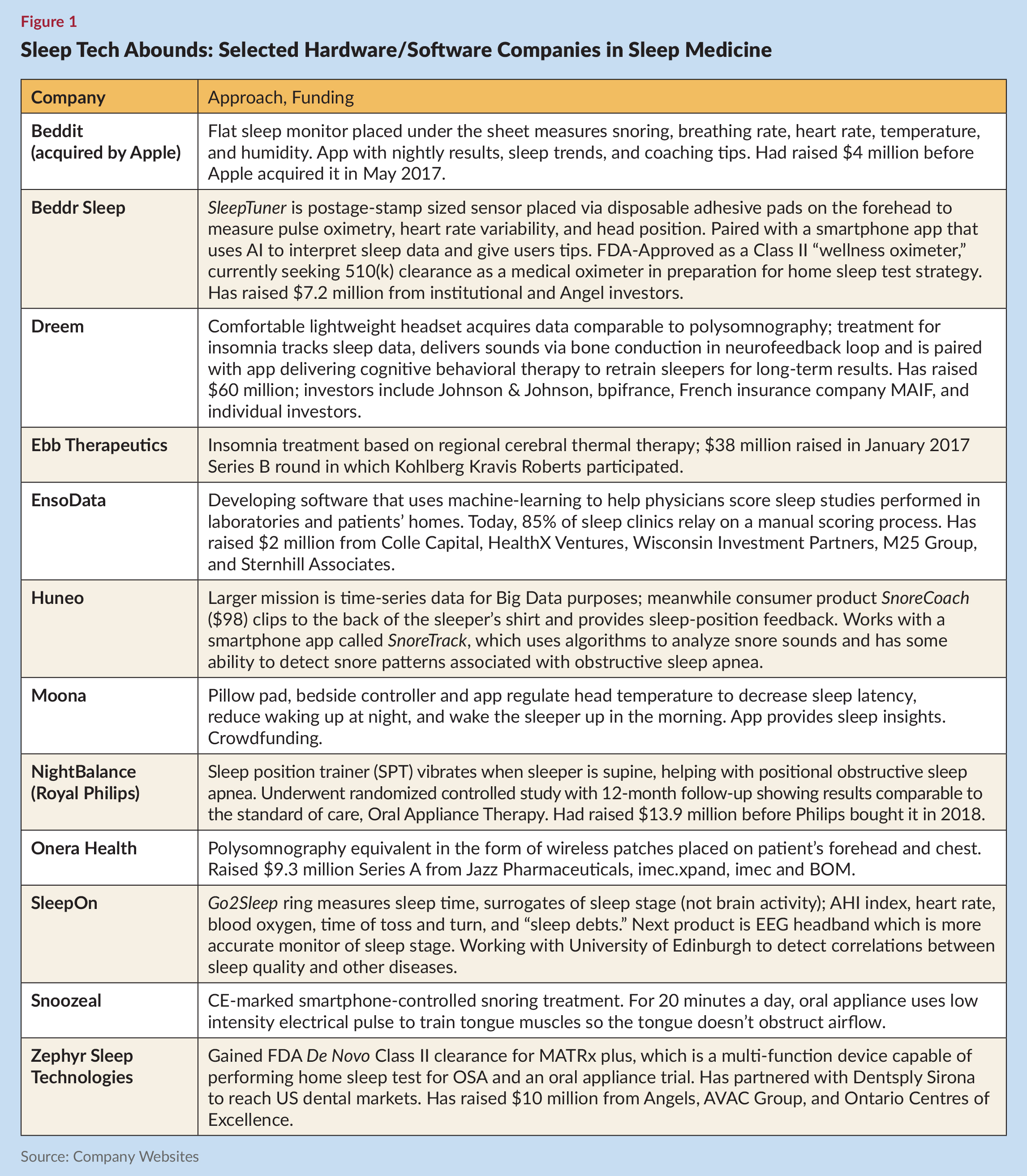ARTICLE SUMMARY:
New sleep tracking technologies have the potential to create patient data that the sleep specialty has never had before. Insights from a growing body of longitudinal sleep data may help in the diagnosis and treatment of chronic diseases in which sleep disorders drive disease processes and compromise outcomes.
While researchers have defined what a healthy sleep architecture looks like—seven or eight hours during which a person passes through four stages with different levels of brain activity, changes in muscle tone, body temperature, and heart rate changes—it’s always been challenging to uncover the sleep architecture for a given patient, simply because the present method of diagnosing sleep disorders in brick-and-mortar sleep laboratories is expensive, cumbersome, and not reflective of real-world experience.
Recently, the tools of modern technology have come together to help sleepers and clinicians answer questions about their sleep. Sleep tech companies abound, now having at their disposal artificial intelligence, apps, wearables, sensors, and other nanotechnology. It’s a crowded space in which it can be difficult to separate the wheat from the chaff. Some companies fit into the category of general wellness consumer products, and into this bucket fall things like apps that track body position, movement, and snoring to give people some idea of the quality of their sleep and coach them around helpful sleep behaviors. In the consumer category, there are even smart pillows, mattresses and sleeping rooms that track physiologic parameters and adjust the environment (cooling or warming, for example) so sleeping conditions are optimal for an individual (see Figure 1).
Others, a smaller number, are focused on providing medical grade information that helps clinicians better diagnose and treat patients, while at the same time supporting the patient. (See, for example, “Beddr: A Head-On Approach to Sleep Tracking,” MedTech Strategist, June 13, 2019.) There is some overlap between consumer and medical strategies, and some companies serving professional markets have initial direct-to-consumer strategies, which, in information technology spaces, is a classic way to get the user input that informs future product iterations.
Out of a crowded field, we’ve selected two companies which, in their stated goals of collecting longitudinal sleep data of the highest quality, are laying the groundwork for disruption in the sleep specialty.
Onera Health Inc. is breaking a bottleneck in the diagnosis of sleep disorders with a set of patient-friendly wireless wearable patches that were designed to provide information equivalent to laboratory equipment known as polysomnography (PSG), the gold standard for diagnosing sleep apneas and other sleep disorders. It will enter the market as a diagnostic platform, targeting professionals and seeking FDA approval as an alternative to today’s PSG systems. At the same time, it aims to provide a consumer experience that is convenient, easy, and comfortable.
Dreem SAS has gone directly to consumers with a wearable headset and an app for treating insomnia; but it too collects medical grade sleep data that correlates well with polysomnography, to underpin future advances in sleep medicine.
These two companies differ from many others because they not only collect data about a patient’s heart rate, position, and breathing, as do many apps, they also monitor brain activity through the use of EEG sensors. The latter is important for creating a picture of a patient’s sleep architecture, i.e. how he or she moves through the various stages of sleep from awake to light sleep to dreaming and finally to the REM [rapid-eye movement] stage.
The sleep tech space is still in its infancy but it’s extremely promising. Clinicians have never before had the type of patient time-series information that nightly sleep trackers can provide, and this could open many new avenues of understanding and therapy for sleep medicine and for chronic diseases.
Sleep tech plays to all of the major themes of healthcare today: an aging population, the burden of chronic diseases, the need to rein in growing healthcare costs by shifting care to lower cost settings, improving outcomes, engaging patients in their own healthcare, and finally, Big Data. Sleep occupies a third of every day; imagine what could be done with eight hours’ worth of daily physiological data collected by sleep tracking technologies. As is the case in any white space opportunity, it will take a great deal of thoughtfulness for companies to find the right applications and comprehensive solutions. But Onera and Dreem, in engaging both patients and clinicians to solve well defined problems, have made a great start.
#SleepTech #Sleep Disorders #Sleep Data #OneraHealth #Dreem #MedicalDevice #CommunityBlog #medtech #medicaldevices #MaryStuart #MedTechStrategist #strategy #medtech #strategist
![]() Trial MyStrategist.com and unlock 7-days of exclusive subscriber-only access to the medical device industry's most trusted strategic publications: MedTech Strategist & Market Pathways. For more information on our demographics and current readership click here.
Trial MyStrategist.com and unlock 7-days of exclusive subscriber-only access to the medical device industry's most trusted strategic publications: MedTech Strategist & Market Pathways. For more information on our demographics and current readership click here.

